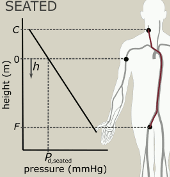
Measuring arterial pulse transit time (PTT) to estimate blood pressure (BP) without conventional brachial cuff-based measurement is not new, but is a focus of current wearable technologies research. Much research pertains to efficient, accurate sensing of artery-related waveforms, yet the relationship between PTT and BP receives less attention despite being key for accurate BP estimation. This study investigated BP/PTT calibration by quantifying anatomical site variability (n=10, 3 female, age 30±9 years) and individual variability (n=103, 50 female, age 53±22 years).
BP and pulse wave velocity (PWV) were measured both seated and supine. Carotid-femoral PWV (cfPWV), carotid-radial PWV (crPWV) and carotid-finger-volume PWV (cvPWV) were measured with the wrist and hand positioned at the level of the upper thigh to achieve the same hydrostatic pressure effect across all measurements.
The postural change invoked a small (4±7 mmHg) change in brachial diastolic BP with an additional 27±2 mmHg change in hydrostatic pressure. cfPWV decreased in the supine position (-1.75±0.17 m/s, p<0.001) but crPWV and cvPWV were more variable. The calibration term (∆BP}/∆PWV) across the sample population varied from 6.6 to 98.3 mmHg/(m/s) (mean 22±14 mmHg/(m/s)) and was correlated with age, heart rate, diastolic and pulse pressure, and weight. These variables did not explain the majority of the variability (R2=0.248).
There is anatomical site and between-individual variability in the calibration term for BP estimation from PTT. Using and accurately calculating hydrostatic changes in BP within the individual may be one method to increase accuracy of this calibration term.

